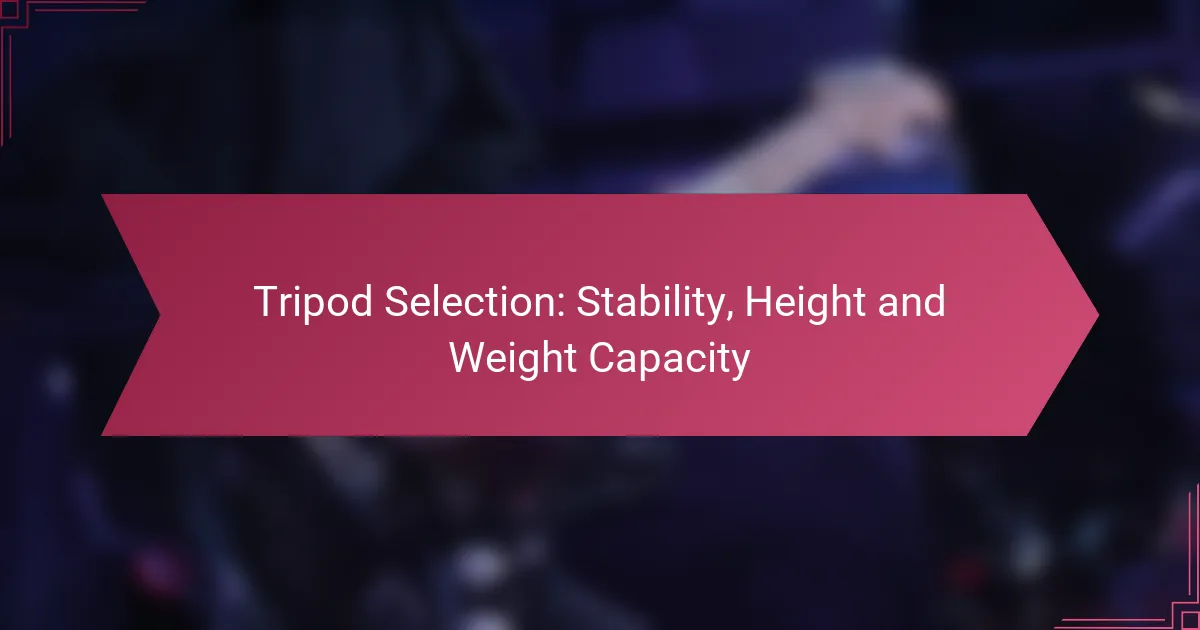When selecting a tripod, it’s crucial to consider stability, height, and weight capacity to ensure optimal performance. Stability is influenced by design features such as a wide base and effective leg locking mechanisms, while the right height allows for better composition in your shots. Additionally, ensure that the tripod’s weight capacity can comfortably support your camera and gear, ideally at least double the total weight for enhanced stability.

What Tripod Features Ensure Stability?
Stability in a tripod is primarily determined by its design features, which include a wide base, high-quality materials, effective leg locking mechanisms, proper weight distribution, and vibration dampening capabilities. These elements work together to minimize movement and ensure that your camera remains steady during use.
Wide base design
A wide base design enhances a tripod’s stability by providing a larger footprint on the ground. This design helps distribute weight evenly, reducing the risk of tipping over, especially on uneven surfaces. When selecting a tripod, look for models with adjustable legs that can adapt to various terrains.
Material quality
The materials used in tripod construction significantly impact its stability. Aluminum and carbon fiber are common choices; aluminum is typically heavier but more affordable, while carbon fiber offers a lightweight option with excellent strength. Consider the trade-offs between weight and durability based on your photography needs.
Leg locking mechanisms
Leg locking mechanisms are crucial for maintaining stability, as they secure the tripod legs in place. Twist locks and flip locks are the two main types; twist locks provide a more streamlined design, while flip locks allow for quicker adjustments. Ensure that the locking mechanism feels secure and operates smoothly to avoid accidental collapses.
Weight distribution
Proper weight distribution is essential for a stable tripod setup. A tripod should ideally support a weight capacity that exceeds the combined weight of your camera and lens. As a rule of thumb, choose a tripod that can hold at least double the weight of your gear to ensure stability, especially in windy conditions.
Vibration dampening
Vibration dampening features help reduce camera shake caused by external factors like wind or movement. Some tripods come with rubber feet or spikes that grip the ground better, while others may include built-in dampening systems. When selecting a tripod, consider models that offer these features for improved image clarity, particularly in long exposure shots.

How to Choose the Right Height for Your Tripod?
Choosing the right height for your tripod is essential for achieving stability and optimal composition in photography. Consider your own height, the type of shots you plan to take, and the adjustable range of the tripod to ensure it meets your needs.
Adjustable height range
The adjustable height range of a tripod refers to the span between its minimum and maximum heights. Most tripods offer a range from about 50 cm to over 180 cm, allowing flexibility for various shooting scenarios. When selecting a tripod, ensure that its height range accommodates both low-angle shots and standard eye-level photography.
For instance, if you frequently shoot landscapes or group photos, a tripod with a greater height range will be beneficial. Conversely, if you often capture macro photography, a model that can lower to ground level is essential.
Maximum height specifications
Maximum height specifications indicate how tall a tripod can extend, which is crucial for standing shots or when shooting over obstacles. A tripod that reaches at least 150 cm is generally suitable for most photographers. However, taller individuals may require models that extend beyond 180 cm to avoid bending down during shoots.
Keep in mind that taller tripods can sometimes compromise stability, especially in windy conditions. Look for models that feature wider bases or additional stabilizing features to maintain balance at greater heights.
Minimum height considerations
Minimum height considerations are important for achieving low-angle shots or when working in confined spaces. Most tripods can lower to around 30 cm, but some specialized models can go even lower. This capability is particularly useful for macro photography or capturing unique perspectives.
When evaluating minimum height, check if the tripod has a center column that can be reversed or removed, allowing for even lower positioning. Ensure that the tripod remains stable at these lower heights to avoid camera shake.

What Weight Capacity Should You Look For?
When selecting a tripod, consider its weight capacity to ensure it can support your camera and any additional gear. A good rule of thumb is to choose a tripod that can hold at least double the weight of your camera setup for optimal stability.
Camera weight compatibility
Camera weight compatibility is crucial for ensuring your tripod can safely support your equipment. Check the combined weight of your camera, lens, and any accessories like microphones or lights. For example, if your setup weighs around 3 kg, look for a tripod that can handle at least 6 kg.
Many tripods list their weight capacity, so compare this with your gear’s total weight. If you plan to upgrade your camera or lens in the future, consider a tripod with a higher weight limit to accommodate potential changes.
Load stability factors
Load stability factors include the tripod’s design, leg configuration, and the quality of materials used. A tripod with a wider base and thicker legs generally offers better stability, especially in windy conditions or uneven terrain. Look for features like rubber feet or spikes that enhance grip on various surfaces.
Additionally, consider the tripod’s center column. A lower center of gravity improves stability, while extending the column can introduce wobble. For heavy setups, avoid extending the center column whenever possible.
Tripod material impact
The material of the tripod significantly affects its weight capacity and stability. Common materials include aluminum and carbon fiber. Aluminum tripods are typically heavier but more affordable, while carbon fiber models are lighter and often more stable, making them ideal for travel and outdoor photography.
Evaluate your needs: if you often shoot in rugged environments, a durable carbon fiber tripod may be worth the investment. However, for casual use, a sturdy aluminum tripod may suffice without breaking the bank.

What Are the Best Tripod Brands for Stability?
For stability, the best tripod brands are those known for their robust construction and reliable performance in various conditions. Manfrotto, Gitzo, and Benro are top contenders, each offering unique features that cater to different photography needs.
Manfrotto
Manfrotto tripods are widely recognized for their durability and ease of use, making them a favorite among both amateur and professional photographers. Their products often feature aluminum or carbon fiber legs, providing a solid foundation while remaining lightweight.
When selecting a Manfrotto tripod, consider the model’s weight capacity and height range. Many models can support equipment weighing up to 15 kg, making them suitable for a variety of cameras and lenses. Look for features like quick-release plates and adjustable leg angles for added versatility.
Gitzo
Gitzo is synonymous with high-end tripods that prioritize stability and precision. Their carbon fiber tripods are engineered to withstand harsh conditions while offering excellent vibration dampening, which is crucial for long-exposure photography.
Gitzo tripods often come with advanced locking mechanisms and leg sections that allow for precise height adjustments. Models can typically support heavier setups, often exceeding 20 kg, making them ideal for professional photographers who require maximum stability.
Benro
Benro offers a range of tripods that balance affordability and performance, making them a great choice for enthusiasts. Their tripods are constructed from aluminum or carbon fiber and are designed to be both lightweight and sturdy.
When choosing a Benro tripod, pay attention to the load capacity, which can range from 8 kg to over 15 kg depending on the model. Features like twist locks and multi-angle leg positions enhance usability, allowing for creative shooting angles without sacrificing stability.

How Do Tripod Materials Affect Performance?
The materials used in tripods significantly influence their performance, particularly in terms of stability, weight, and durability. Choosing the right material can enhance your photography experience by providing the necessary support for your camera equipment.
Aluminum vs. carbon fiber
Aluminum tripods are generally more affordable and offer decent stability, making them a popular choice for casual photographers. However, they tend to be heavier than carbon fiber options, which can be a drawback for those who prioritize portability.
Carbon fiber tripods, while typically more expensive, provide excellent strength-to-weight ratios. They are lighter and often more stable in windy conditions, making them ideal for outdoor photography. Consider your budget and how often you’ll be transporting the tripod when making a choice.
Durability and weight trade-offs
When selecting a tripod, durability and weight are crucial factors to consider. Aluminum is durable and resistant to dents, but it can corrode over time if exposed to moisture. Carbon fiber, on the other hand, is resistant to temperature changes and less likely to suffer from wear and tear.
Finding the right balance between durability and weight is essential. For instance, if you frequently hike to remote locations, a lightweight carbon fiber tripod may be worth the investment. Conversely, if you mostly shoot in stable environments, a heavier aluminum tripod could suffice and save you money.

What Accessories Enhance Tripod Functionality?
Several accessories can significantly enhance the functionality of a tripod, making it more versatile for various photography needs. Key accessories include quick-release plates, tripod bags, and stabilizers, each serving specific purposes to improve usability and stability.
Quick-Release Plates
Quick-release plates allow for fast attachment and detachment of your camera from the tripod. This feature is particularly useful for photographers who frequently switch between handheld and tripod shooting. Look for plates that are compatible with your tripod’s head type to ensure a secure fit.
When selecting a quick-release plate, consider the size and weight of your camera. Most plates are designed to accommodate a range of camera models, but a snug fit will enhance stability during shooting. Investing in a high-quality plate can prevent camera shake and improve overall image quality.
Tripod Bags
Tripod bags provide protection and ease of transport for your tripod. A well-padded bag can safeguard your equipment from damage during travel, while adjustable straps make carrying more comfortable. Choose a bag that fits your tripod’s dimensions and offers additional storage for accessories.
When selecting a tripod bag, consider the material and weather resistance. A durable, water-resistant bag is ideal for outdoor photography, ensuring your equipment remains safe in various conditions. Additionally, look for bags with extra compartments for storing quick-release plates and other accessories.
Stabilizers
Stabilizers, such as tripod weights or stabilizing arms, enhance tripod stability, especially in windy conditions or on uneven surfaces. Adding weight to the tripod’s center can significantly reduce vibrations and improve image sharpness. This is particularly beneficial for long-exposure photography.
When using stabilizers, ensure they are compatible with your tripod model. Weights should be easy to attach and detach for convenience. For outdoor use, consider portable options that can be easily packed and set up in various locations.
